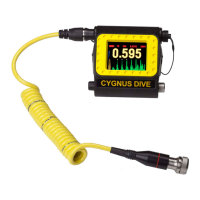Page 98 of 118
18. General Points on Thickness Gauging using
Multiple Echo Measurements
On very rough surfaces and especially if both sides are badly
corroded, it is often necessary to move the probe around to locate
a back wall reflector. Sometimes a slight rocking movement can
help find reflectors which are otherwise impossible to detect.
Keep the probe face flat against the surface – the ultrasound is
like a torch beam, it must be shone straight into the material so it
can reflect straight back. If you tilt the probe the beam may not
reflect back to the probe and you won’t get a measurement.
Beware that in extreme conditions or if the plate is of poor quality
and contains many inclusions the ultrasound will be scattered to
such an extent that measurement may not be possible.
Beware that the multiple-echo technique will not work if the front
and back surfaces of the material being measured are not parallel.
Long narrow bars cannot be gauged along their length with the
multiple-echo method.
The gauge should not be used near arc-welding equipment, as this
affects its performance.

